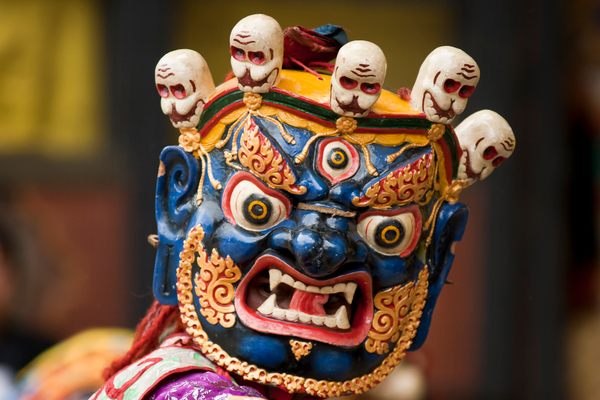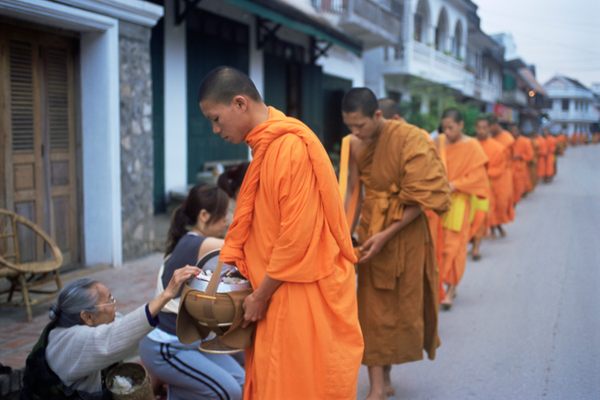Death and the Year of the Horse at the Hsi Lai Temple and Buddhist Columbarium
The Year of the Horse being celebrated at the Hsi Lai Temple
To celebrate the Chinese New Year and usher in the Year of the Horse, the Los Angeles Obscura Society headed east of LA to the suburbs of the San Gabriel Valley (SGV). The SGV has the largest diaspora of ethnic Chinese immigrants in the United States. Nestled in the hills of Hacienda Heights — one of the cities that makes up the SGV — sits the Hsi Lai Temple.
The temple was constructed in 1988, and Hsi Lai translates to “coming west,” signifying the first foothold of the Fo Guang Shan Buddhist Order in the Western Hemisphere. This Buddhist order is the largest from Taiwan, and the Hsi Lai Temple is the largest Buddhist temple in North America. The temple was built to serve as a spiritual and cultural center for those learning Buddhism and Chinese culture.
In non-holiday periods, the temple, while still majestic, is much more serene and zen-like. Our visit was at the most festive and busiest of Chinese celebrations, so it was more of a carnival atmosphere with decorations all over the temple and vendors selling their wares and food items. Our tour started at the gateway structure at the front of the temple. The Chinese characters on the back of the gate list the four universal vows of Buddhism: “To save all sentient beings, to eradicate all worries, to study the boundless Dharma, and to attain supreme Buddhahood.”
The LA Obscura Society poses in front of the Gateway
I explained to the group that the Fo Guang Shan organization had difficulty building the temple and encountered stiff neighborhood resistance in selecting a site for it. The organization was rejected in the South Bay and Alhambra by people suspicious of the group, but they were able to finally succeed in their third site in Hacienda Heights.
The Hsi Lai Temple has overall been a beneficial presence within its community, but it did get some unwanted attention back in 1996 when it became embroiled in campaign finance controversy during the presidential campaign related to a luncheon for Al Gore. Several of the nuns and employees were indicted, and one nun was convicted, while two others fled back to Taiwan and never returned.
The Gateway
Following the initial history lesson, we entered the temple through the gilded Bodhisattva Hall. Bodhisattvas are enlightened beings, sort of “buddhas in training.” Five bodhisattvas are honored in the hall, and there are two more bodhisattvas outside the shrine — those two serve as guardians and represent stronger and fiercer aspects of Buddhism.
After passing through the Bodhisattva Hall, the group was greeted with a kaleidoscope of colors and scents. The entire spectrum, especially red and gold, was in the decorations. The scents were a mix of incense and the very distinct rotting garbage odor from the stinky tofu sold by the vendors. The large central courtyard, which is normally barren, was filled with all types of decorations highlighting the Year of the Horse, along with many ways to increase one’s chances of good fortune for the new year.
Performing a ritual with an incense stick
Costumed figures at the celebration
One way to get good fortune was to to toss a coin and ribbon up the golden tree and hoped it sticks on the branches
There was a golden tree that was decorated with hundreds of crimson red ribbons. Participants were encouraged to throw golden medallions with red ribbons at the tree, hoping they would get caught in its branches to signify good fortune.
Nearby there was a makeshift tent with hanging plastic bottles partially filled with red water. If you stood underneath it, it was another way to get good luck. Over at the Arhat Garden, people were encouraged to throw coins and try and hit a bell for good luck. In front of the main shrine, they were handing out free incense sticks — again another way to cleanse the past year away. Candles in pineapple shaped vases were sold and lit as the prickly fruit is a symbol of prosperity.
Pineapple prosperity candles
Pineapple shaped containers for candles
In the temporary exhibit on Buddhism, worshippers were allowed to bathe a Buddha statue
The information center, which normally looks more like an office, was transformed into a temporary museum on Buddhism. Again there were a variety of ways to try and get good fortune by either bathing a Buddha statue with a cup of water, or writing down your wish on paper and sticking it on a “wishing wall.”
The main shrine, which usually is the focus of the temple, seemed more of a side attraction trying to compete with everything else going on. The shrine’s name means “Precious Hall of the Great Hero.” On an ordinary day, the church is where they hold mass. Inside the main shrine are three large statues of Buddhas, each one a different incarnation of the divine being. If you look closely at the walls, you notice over 10,000 Buddha statues.
The last two sections of the temple we visited were more serene. Even covered in gold paint, the statues in the Avalokitesvara Garden seemed tame compared to everything we saw earlier. People could throw coins at the fountain in the middle for good luck. We ended the tour visiting the small museum inside the temple called Fo Guang Yuan Hsi Lai Art Gallery, which gives you a better understanding of the history of Buddhism and the order that established the temple.
The columbarium at Rose Hills Memorial Park
After departing the temple, we headed west to the neighboring city of Whittier to Rose Hills Memorial Park. By size, it’s the largest cemetery in the United States, and holds the graves of Alvin Ailey, Jr, Timothy Carey, Jaime Escalante, Nguyen Cao Ky (prime minister of South Vietnam), and Eazy-E. But we weren’t here to focus on the graves of celebrities and politicians. We were there to visit the Buddhist Columbarium at the very top of Rose Hills.
The Buddhist cemetery alongside the columbarium
The Buddhist columbarium
Some of the niches in the columbarium have personal effects memorializing the deceased
Built in 1999, it is the largest Buddhist pagoda and columbarium in the country. The three-story structure contains 21,000 places for cremated remains.The complex is guarded by statues of the four deva-kings in the front, and surrounded by 60 Buddha statues. We ended our day at this serene place as it’s where the members of Fo Guang Shan’s Hsi Lai Temple are buried and was specifically built to house their ashes. (However, contrary to all the good luck activities of the temple, the Chinese ordinarily avoid visiting cemeteries in the New Year because they consider it bad luck.)
After the sensory overload we experienced at the Hsi Lai Temple, the Buddhist Columbarium was a perfect and peaceful way to end our exploration and celebration of the Chinese New Year.
Statues receiving sentient beings of this Saha world encircle the columbarium
View to LA and the San Gabriel Valley from the third floor of the Columbarium
The Obscura Society is the real-world exploration arm of Atlas Obscura We seek out secret histories, unusual access, and opportunities for our community to explore strange and overlooked places hidden all around us. Join us on our next adventure!
All Upcoming Obscura Society Events
















Follow us on Twitter to get the latest on the world's hidden wonders.
Like us on Facebook to get the latest on the world's hidden wonders.
Follow us on Twitter Like us on Facebook